Siemens Logistics is taking its portfolio of baggage handling solutions to the next level. Tara Craig hears how.
Versatile automation
The holy grail for airports today is optimisation of both staff and equipment. Automation – such as that provided by Siemens Logistics’ VarioTip – holds the key.
Launched in 2022, VarioTip is an automated system for high-throughput baggage handling, helping airports cut transfer times and achieve a low left-behind index. A powerful tilting device means it can empty up to 20 unit load devices (ULDs) in the arrival and transfer areas and process around 800 bags per hour. After emptying, it feeds the singulated baggage items into the airport’s existing system.
Automating complex logistics processes is one of the biggest challenges at airports
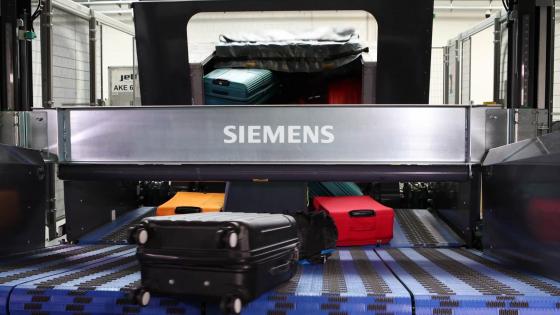
VarioTip’s powerful tilting device enables it to process around 800 bags per hour
By automating labour-intensive manual processes at the BHS-apron interface, VarioTip drives greater efficiencies in ground handling operations.
Created with versatility in mind, VarioTip can unload various ULD sizes. Its compact, modular design means the device can be configured to suit different technical and spatial requirements and can easily be integrated into almost any existing conveyor system, something that is especially valuable in these cash-conscious times, when a new BHS may be out of an airport’s financial reach.
Michael Schneider, CEO of Siemens Logistics, said: “Automating complex logistics processes is one of the biggest challenges at airports. With VarioTip, we developed an ideal solution specifically for ground handling operations. Our innovation not only reduces manual efforts and physical strain. It also helps increase the speed, efficiency and sustainable performance of baggage transfer operations.”
The Munich Airport trial
VarioTip is undergoing trials at Munich Airport, a long-standing Siemens Logistics customer. It was integrated into the existing BHS in the Terminal 2 arrivals zone, and the pilot project was carried out during live operations. The airport’s priorities were a reduction in manual intervention, better baggage handling processes and greater efficiency in ground handling, resulting in enhanced workplace safety. The device achieved an automatic ULD unloading rate of around 99%, optimised baggage handling and improved ergonomics for ground handlers.
Munich Airport has been pleased with the pilot. Hauke Hedderich, head of processes and central infrastructure at Terminal 2 Gesellschaft, which provides terminal services, said: “Besides focusing on efficiency, we aim to achieve a high level of workplace ergonomics, to make jobs more attractive in the long term. After installing VarioTip in our system and running numerous tests under real operating conditions, we were convinced by its powerful, reliable performance. VarioTip will help us further optimise ground handling in Terminal 2.”
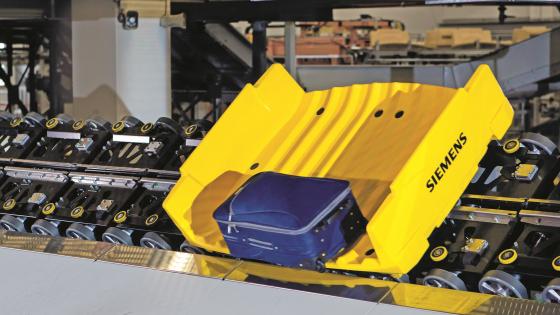
VarioTray is a modular system capable of sorting and transporting even large and bulky items such as surfboards and skis
Harnessing the cloud
A powerful baggage management software solution, Siemens Logistics’ Baggage 360 ensures seamless operations and transparency across end-to-end baggage processing – right from the point of check-in to the arrival of both baggage and passenger at their final destination. It has already been shown to reduce the number of misconnected bags and the associated costs at a number of major hubs, among them Dubai Airports, thanks to its clever optimisation of baggage flow and the transparency it brings to the process. Furthermore – and particularly important in today’s post-pandemic recovery period, when costs must be kept down – Baggage 360 improves the speed and efficiency of numerous baggage handling processes, enabling airports to handle more traffic and baggage without having to hire additional staff or redeploy existing workers who may be needed elsewhere. And there is no underestimating the value of the transparency the solution brings – traceability of bags in real time and even when outside the BHS will be of enormous benefit to everyone, from airports and airlines to passengers.
The Baggage 360 software offers a wide range of features, from real-time monitoring of operational processes and an interactive map through to advanced predictions based on machine learning.
Every single bag can be tracked from check-in to arrival, with operators even able to pinpoint the ULD in which a particular suitcase is located.
Its open interfaces also mean Baggage 360 can be implemented at any airport as software as a service (SaaS), regardless of size or operating system. The apps are highly scalable, enabling businesses to access more features and services as they grow.
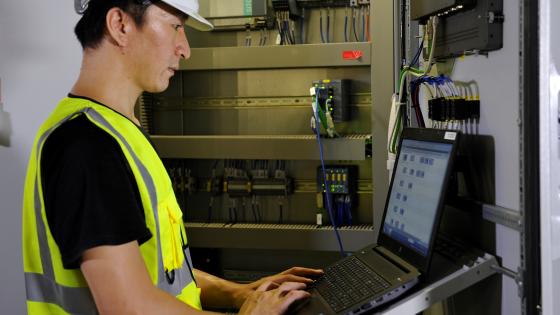
BagIQ provides an integrated BHS software solution for airports of any size
In a league of its own
What sets Baggage 360 apart? It’s simple – it is the only solution on the market capable of forecasting future baggage volumes and the level of criticality within. Its forecasting functions utilise advanced AI and machine learning algorithms to anticipate baggage volumes for the next 24 hours, identifying potential bottlenecks or malfunctions. This helps airports and ground handlers deploy staff and equipment with greater precision than before, saving money and staffing resources.
Tanya Wilson, product manager airport operational systems at Dubai Airports, describes Baggage 360 as “a game-changing application that has enhanced the efficiency of our airport”. Wilson added: “We realised what we could achieve with this application from the very beginning. We can see tomorrow’s baggage flow today.”
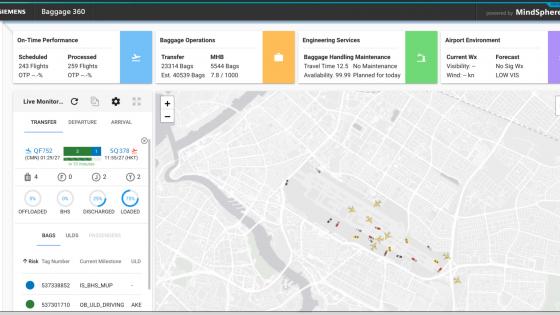
The Baggage 360 suite offers real-time monitoring and forecasting of operational processes along with an interactive map
Mind over matter
Once checked in at the airport, baggage makes its way through kilometres of conveyors and sorting systems, perhaps even via the early bag store. For all baggage to reach the correct aircraft on time, behind-the-scenes processes must be smoothly interlinked and coordinated. High-performance conveyor systems must be complemented by reliable control software, also known as high-level control (HLC).
BagIQ is the latest version of Siemens Logistics’ HLC, regulating the baggage handling processes at airports, from allocation planning and baggage screening to system visualisation.
As the brain of the baggage system, it makes all BHS elements and installations visible and steerable, increasing the efficiency of airport baggage handling operations. BagIQ offers cybersecurity by default, thanks to a scalable and secure system that exceeds the latest safety standards. The HLC enables the various elements of the BHS to run seamlessly in tandem, including the early bag store, belt conveyors, sorters and trays. The software is compatible with all baggage handling systems, including those of third parties.
A world of difference
Aviation is changing rapidly, as are airports and the demands placed upon them, whether political, financial or environmental. Travellers’ needs are evolving and it is incumbent on manufacturers to ensure their clients are equipped to meet them economically, effectively and safely. Siemens Logistics continues to innovate to do just that.
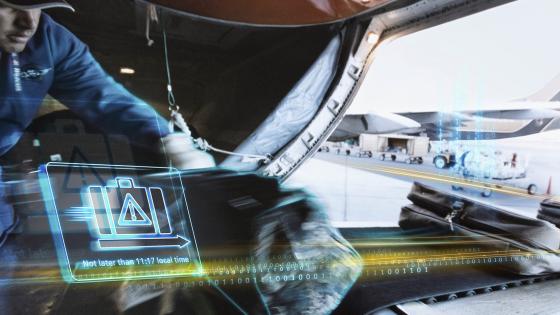
Cost and efficiency pressures have made the digitalisation of baggage handling processes essential, Siemens Logistics says
Need to know more: Prevention is better than cure
The reliability of baggage handling systems (BHS) is crucial to the effective operation of airports and airlines. Failures can have a significant impact on the many handling processes, from baggage check-in to conveying and sorting bags. The implications are costly and far reaching: potentially disrupting flight schedules, leaving aggrieved passengers to travel without their baggage and damaging both bottom lines and reputations.
Prevention is clearly better than cure. Airports need to be able to identify the signs of deterioration to their BHS in good time and know what level of maintenance is required and when. Maintenance can range from basic (corrective) to highly advanced (predictive); the former is required only in response to a breakdown, while the latter involves gathering condition data and evaluating this by means of algorithms.
This is where Siemens Logistics’ Service 4.0 portfolio comes in. Its digital maintenance solutions collect data on the condition of components, among them rollers, tracks and carriers. This is known as condition monitoring.
Machine learning algorithms then analyse and evaluate the condition data obtained, recognise patterns in historical data, compare them with current values and thus identify irregularities. Siemens Logistics’ smart maintenance solutions use condition monitoring and predictive maintenance to forecast the health of equipment, thus anticipating problems. This helps customers achieve higher system availability and reliability, thanks to optimised maintenance scheduling and execution with just-in-time measures. It enables more transparent and efficient spare parts management and requires less manual work, meaning that personnel can be deployed elsewhere in the airport.
Siemens Logistics’ Service 4.0 applications keep costs controlled, support sustainability and extend the service life of components by reducing the frequency of maintenance work, the number of unplanned breakdowns and the waste of resources (working hours, spare parts, material) through unnecessary servicing.
